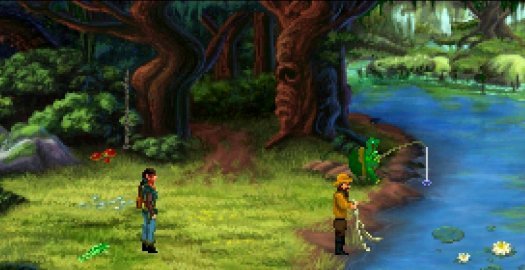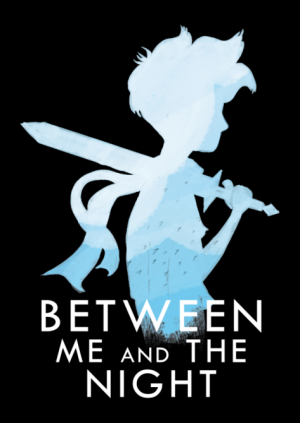Review for Order of the Thorne: The King’s Challenge

Nostalgia is trending heavily in all forms of media these days, and certainly most adventure fans who lived through the early 1990s period that we affectionately call the Golden Age harbor an extra-large portion of nostalgic fondness for the games of yore. Infamous Quests, which began its life as an amateur developer of free VGA remakes of first-generation Sierra adventures (their outstanding Space Quest II remake is possibly the best of the kind), transitioned into a commercial studio trading heavily on nostalgia with the 2014 release of Quest for Infamy and have now taken a further step forward with the debut of a new "anthology" series. Order of the Thorne possesses some of the same uneven qualities as its immediate predecessor, but ultimately allows me to pay it the highest compliment for those who value the glory years highly: this feels as much like a 1991 release as you could hope for.
The first installment, The King’s Challenge, is an introduction to the land of Uir. You play as Finn the Bard, a young quester with no battle or combat skills, just his bard-like charm and a lute. Finn has journeyed to Uir to challenge six other heroes in a simple test: the Queen has hidden herself in the realm, and the first to locate her will receive a wish granted by King Quilhairn and the title Champion of the Fairie Realm. It’s a very simple story and it does not twist and turn; nor do you cross paths with your fellow adventurers very much. Some attempt to build narrative and backstory is made, but this series debut seems largely content to embrace the simplicity of a straightforward fairy tale adventure.
Quest for Infamy billed itself strongly as a comedic adventure, but there is a significantly more muted tone in the writing this time around. There is certainly nothing resembling the slapstick-y guffaws of Space Quest, and very little of the droll wit that Quest for Glory displayed brilliantly. Instead, The King’s Challenge takes itself very seriously and is much less concerned with eliciting laughter. In doing so, it upholds the sincerity and wonder of the classic fantasy adventure in the mold of Sierra’s flagship King’s Quest series. The ingredients of a dashing young hero, a wise old king, a beautiful lost queen, and an assortment of eccentric supporting characters are intact and undisturbed from typical genre conventions.
In fact, the whole thing is so solemn and the writing so straightforward that it’s almost bland at times… and in the blandness comes one of the more curious choices: the casting of professional voice actor Jesse Lowther as the narrator. Lowther is a fine actor, to be sure, but his rich baritone carries the deadpan I-know-something-you-don’t satirical abilities of a Gary Owens or Leslie Nielsen perfectly. Unfortunately, that’s not what the script calls for and Lowther’s dramatic over-emphasis frequently leaves you waiting for a punchline that just never comes. A much more appropriate choice would have been a softer narrator with a light but earnest storytelling touch similar to Bill Ratner, the gold standard in adventure narration for his work on King’s Quest VI.
The narration also features an annoying design fault: even with voice-overs turned on, a mouse-click is required at the end of each text screen to advance to the next one. Perhaps I can’t get the way things used to be out of my head, but it seems completely and unnecessarily non-standard for a conversation, or a series of connected narrations, to not just proceed unhindered without having to constantly click to move them forward. Of course, since all narrations are subtitled, if you’d rather just read ahead you’re free to click through it early.
The voice work of the in-game characters is very well done. Matthew Curtis is outstanding as Finn, embodying the young optimism of a questing hero. No other characters play significant roles, but all are well-cast and excellently directed. There are at least 15 different supporting characters with speaking parts, from helpful townspeople to forest-dwelling dwarves and mischievous pixies, and none of them leave a negative impression.
The music, however, is a much more mixed bag. The introductory soundtrack is a bizarre synth-heavy homage to the 1980s that—similar to my issue with the narration—almost does the disservice of framing the game early on as a kind of self-aware satire. The music throughout the game changes constantly as you move from area to area, sometimes traditionally classical and then sometimes oddly modern and poppy. In a game where navigation is quick and you’ll need to move around frequently as you explore, the quick fade-outs and fade-ins are distracting.
Though Order of the Thorne takes many of its cues from VGA-era Sierra adventures, it does not use the traditional icon-focused interface, instead using a single-cursor left-click to interact, right-click to look scheme. Character conversations mostly consist of working through a list of available inquiries, which increases appropriately as you learn new information. The player character moves very rapidly across the screen—which is good, because there is no fast-travel or map built into the game. True to its roots, it also lacks an internal hint system or hotspot highlighter, but there are no instances of pixel-hunting frustration.
For all of its obvious Sierra inspiration, the most interesting interaction element is actually one borrowed reverently from the LucasArts adventure Loom: a lute minigame that has you learning a series of songs, and then playing those to cause specific effects on characters. There are songs of calm, songs of protection, even a song that causes a key character to revert to their true form. The lute grid is a four-by-four fretboard, requiring you to memorize the pattern as you hear it once, and then click all the notes in correct sequence to trigger the spell. There is no penalty for failure, and there is an easy mode as well, which basically allows you to skip the minigame aspect and just use the songs as though they were inventory items.
Other than making use of the lute mechanic, the game’s puzzles are of a traditional inventory nature and structured in a nonlinear way, again very similar to the older King’s Quest games. There are many different items you’ll need to find and use over the course of your travels, and certainly there are some that must be completed in a specific sequence, but in general the entirety of the world is open to you at any moment and you can complete the puzzles in a vastly different order. There is no firm direction to move toward your “first puzzle” after the introduction plays out; instead, the game bids you simply begin exploring the world of Uir.
And that’s a welcome invitation, because Order of the Thorne creates a beautiful world that is worthy of exploring. For a 320x200 resolution VGA game, the amount of detail in the backgrounds is just remarkable. The land of Uir is so lush and colorful, you’ll find yourself just stopping and looking around frequently as you wander its forest, explore its towns, and cross its rivers. There are no shortcuts at all taken in the background design; the many varieties of trees are detailed and unique, as are the plants with their different shapes and sizes. And it’s not just the gorgeous flora; the grim swamp detail drives home the necessary sense of foreboding and the island cemetery is an impressively epic-looking destination.
The lack of linearity, though likely to try the patience of modern gamers with finely-honed critical path instincts, pulled me back to the old days of adventures in a welcome way: since almost each one of the 30-odd outdoor scenes has an important interaction, I actually found myself drawing squares on a piece of paper and writing notes to keep my bearings. I never got tired of just walking around the world, looking at everything around me—and hats off to Infamous Quests for loading up every screen with plenty of hotspots and descriptions. This is not necessarily a long game (with a walkthrough and a disregard for achievements it could be finished in 90 minutes) but since I enjoyed the exploration element, I spent well over four hours in this episode without feeling any artificial stretch and I will be more than happy to return to it in the future.
As an introduction to a land of new mythology, and a first episode of what is billed as a multi-part anthology, I’m not sure The King’s Challenge really succeeds. The series’ mysterious titular order and the “Unknown God” that they worship do not feel central to the story, merely providing some tacked-on backstory toward the end. The fact that the next game will feature an entirely different player character further reinforces that the best way to enjoy this episode is as a standalone throwback to the Golden Age, though presumably future episodes will begin fleshing out a larger story arc that’s barely hinted at here. As a modern adventure for someone whose eyes don’t light up at the sight of a colorful 320x200 outdoor landscape, Order of the Thorne is probably not recommended. But for those who still cherish the feelings that those old games create, beyond the misguided narration and dry writing you’ll find a beautiful and delightful world to explore. This is a game that truly feels like it was designed and released in 1991—and you already know in your heart whether you consider that a compliment or not.
WHERE CAN I DOWNLOAD Order of the Thorne: The King’s Challenge
Order of the Thorne: The King’s Challenge is available at:
- GOG
- Itch.io -80%
- HumbleBundle
Our Verdict:
With its hand-painted 320x200 backgrounds, modest pacing and exploration focus, The King’s Challenge is a solid Golden Age-style fairy tale adventure that stumbles only in its overly serious tone.


_capsule_fog__medium.png)

























